On July 2, 2023, Montreal ranked as one of the worst cities in the world with regard to air quality. Montreal’s air quality scored a 97 on the IQAir scale, representing a “Moderate” risk to the population. Its score was just four points shy of the category “Unhealthy for Sensitive Groups,” which was how the city was classified in late June. Nearby cities such as New York City and Toronto also suffer from poor air quality, and each has scored within the top 12 on the scale.
Poor air quality in major Canadian and U.S. cities is a consequence of the wildfires spreading throughout eastern North America. Of the approximately 400 wildfires currently burning in Canada, Quebec is home to more than a third of them, a quantity highly uncommon to the province. This year has seen a record-breaking number of wildfires in Quebec and a record-breaking number in Canada as a whole.
The wildfires have forced thousands of Quebec residents to evacuate their homes and reside in designated evacuation centres in safe parts of the province. Residents have faced similar evacuation orders in other Canadian provinces, demonstrating the wide-scale impacts of this year’s wildfire season.
In an interview with the Daily, Montreal resident Madeleine Choquette shared some concerns regarding the wildfires.
“I am scared of breathing the particles we have in [our air] because I have asthma,” she said. “I am also worried for the future of my grandchildren. The climactic changes are scary and our governments […] don’t seem to [care].”
Montreal resident and McGill student Divya Kakkar shared a similar statement.
“I find the wildfires heartbreaking. To think about all those decade-old trees simply destroyed so fast is upsetting.”
Choquette and Kakkar bring up a common concern held by many others, that being the worry about what our future looks like regarding the climate, and what it can mean for our landscape.
It is likely that Canada’s future will experience a large number of wildfires each summer, according to Forest Fire researcher Mike Flannigan. Through research at the Canadian Forest Service, he found that climate change will worsen the three key factors initiating wildfires: possession of dry fuel to burn, persistent lightning strikes that spark fires, and dry, windy weather that will fan flames.
In a 2017 study, Flannigan and other scientists predicted what we have seen this summer. They stated that western Canada will see a 50 per cent increase in the amount of windy and dry days that allow fires to start and flourish, and that eastern Canada will see a 200 to 300 per cent increase in such days. Through his research, we can forecast more smoky summers to come.
In November 2021, Canada’s Environment Commissioner released a report showcasing three decades of the government’s deficiency in reducing greenhouse gas emissions and meeting its targets (such as the 2030 NDC target and the 2050 net zero target). Canada is currently rated as “Highly Insufficient” in regard to climate action.
Features unique to Canada such as the vast landscape, northern climate, and small population could be affecting the achievement of climate action goals, especially compared to other countries.
According to the National Centers for Environmental Protection (NCEP), July 4 was the hottest day ever recorded across the globe. The earth’s global temperature reached a staggering 17.18 degrees Celsius, an alarming number for a planet where one-half is experiencing winter.
Dr. Robert Rohde, a lead scientist at Berkley Earth, tweeted that this extreme global heat is “driven by the combination of El Nino on top of global warming, and we may see a few warmer days over the next 6 weeks.”
Canadian residents should prepare themselves for the upcoming heat waves this summer. People who live in areas prone to wildfires should also make any preparations necessary for the event of an evacuation; the Government of Canada provides an Emergency Preparedness Guide on its website. N95 and KN95 masks can also provide protection against polluted air.
